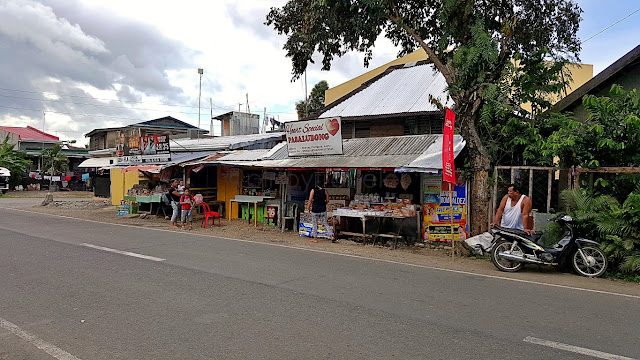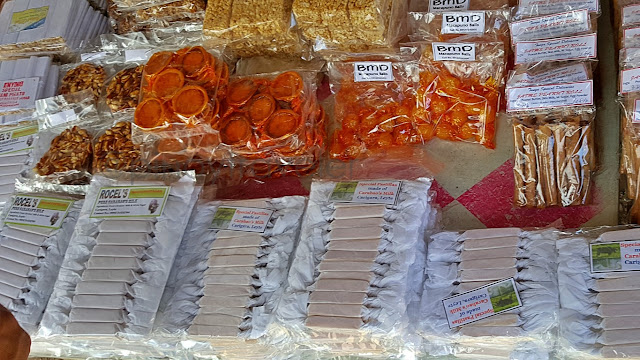Carigara Delicacies as Pasalubong
This was still on my joyride from Calubian to Tacloban, we naturally had to pass by Carigara. This time we "stopped-to-shop" oh ha?! My driver promised his three lovely daughters that he would bring home some pasalubong from Carigara, thus the 'shopping'. He went (I followed) to only this roadside store..,Well, he's been a driver for so long a time, I cannot contest his knowledge on where to buy the best of these pasalubongs! There are many stores on this highway strip, and I think they sell the same things!
As the driver picked what he had to pick (and haggled with the vendors for more] I clicked hehe!Here's the honest deal about me and these sweets from Carigara - or other sweets from anywhere for that matter: I am not really too keen on any of them, such that I'd crave for, or plan to specifically seek them out. BUT - when I get started with ANY of them, there's no telling when I will/can stop. IF at all!
I do not even know or care to know what they are called. Like, the upper left corner is a "pinyato mani"! Yep, they're like the peanut brittle, just a bit on the softer and/or nougaty kind of texture (makunat ba). There are many of those in Buray, Samar. I hate that at times the bond paper used to wrap them would stick to the sweets that it is a challenge to remove them - yet I patiently and painstakingly do so, hehe!
The upper-middle bar-like packs are "pinyato", though sometimes called "ampao". They're rice crispies, stuck together by the same ingredient that binds the peanuts (calamay melt). See? I don't know them!
Those that have the BMD brand are "Macapuno Balls" - ah they're candied shreds of young coconut!
Top-rightmost packs are called "Peanut Rolls". They're like lumpia but in the texture of barquillos (just a bit thicker) but filled with candied peanut like as above but ground to a grainier consistency. Marasa!
The patty-like round things are "Pili Brittle". They're not crackly hard, therefore easier to eat.
The rounded things are "Yema Tarts". They come in all kinds and flavors like pili or whatever else!
The bottom row of packs are all "Special Pastillas" - made of Carabao's Milk. They can also come in many different flavors like Ube, Langka, Mango, etc., etc., WARNING: VERY ADDICTIVE hahaha! I say that because I have many times caught my royal self having finished a whole pack in one sitting - and I was asking for more. At times I make them as palaman in my bread or a partner of Skyflakes!
Now now now.., I just described the picture above!
Here's another photo from the same shelf of the same roadside store..,Top-left is "Polvoron" - aside from the 'plain' or the 'pinipig', polvoron now comes in many flavors. I still like the 'pinipig flavor', but it is getting to be rare nowadays - as in rare in the whole Philippines! I heard from a friend who worked at Goldilocks for a time, that, pinipig flavor is actually tedious to do. So that is purportedly the reason why that flavor is getting to be "extinct" from many polvoron shelves. Argh!
Okay, there are "Bokayo", Tamarind Candy, various flavors of more pastillas, different banana fritters and going rightwards even beyond what the picture can include are the baked products like rosquillos, etcetera, etcetera! Hah!
Needless to say.., it was only my driver who wanted to buy from this store.., but.., my lips are sealed!
Shh.., 'wag maingay.., the doctor is away hehe hehehe!
Let's proceed home na!
Oh, trivia muna! (mahabang kwento ito)
Did you know that Calamay or Kalamay has many different kinds in the Visayas Islands? Yes, and this is another 'makabuang' 'makalilisang' phenomenon of the Bisaya oral cavity!
Foremost and in its simplest form is the Ilongo (Hiligaynon/Negrense) meaning which is "sugar" from the dried sugarcane juice. It was as simple as "kape kag kalamay" (coffee & sugar) during my younger days. It could be brown or white or refined or Victorias, but all of them were called Calamay ah! Sugar!
Being Cebuano did not matter much as to what this thing is. The only problem is it became "camay" or "kamay". As my "mi abuela" would say it "ang Cebuano lenguaje ng tamad magsalita"! Lahat shortcut! Ang "wala" naging "wa", but if you ask any Cebuano to write that, it will contain the four letters of W, A, L and A! Other than the Cebuanized pronunciation, Camay is still sugar - not beauty soap, umayos ka!
When we would visit Bohol.., nanayko, ang calamay or kalamay kay isud na sa bagul gi-higtan'g papel de japon nga "pua" (pula, as in red hehe)! Well, it is not sugar but a glutinous rice delicacy just like the many instances of calamay in Luzon. Kakanin na sya! The only difference is it is too sticky and placed inside a coconut shell with a sash of red papel de japon! Lami baja! Yes Janice, lamiscious!
At naging Waray ako.., the calamay/kalamay of the Warays is not a delicacy but [originally] formed by coco shells too. The Waray calamay is some kind of a hardened molasses - that is melted in water or coconut milk for it to serve a purpose! Oh well, like most waray-waray kids, we would sometimes buy calamay and munch on them like giant lollipops without the stick! Just hide from lola kasi bawal yan!
This latter kind of calamay is what is (generally) used in the Carigara (and waray-waray) delicacies. It is the melted calamay (for example) that is mixed with the 'botong' to become the bokayo. Ganun yun!
Haay katam-is!
As the driver picked what he had to pick (and haggled with the vendors for more] I clicked hehe!Here's the honest deal about me and these sweets from Carigara - or other sweets from anywhere for that matter: I am not really too keen on any of them, such that I'd crave for, or plan to specifically seek them out. BUT - when I get started with ANY of them, there's no telling when I will/can stop. IF at all!
I do not even know or care to know what they are called. Like, the upper left corner is a "pinyato mani"! Yep, they're like the peanut brittle, just a bit on the softer and/or nougaty kind of texture (makunat ba). There are many of those in Buray, Samar. I hate that at times the bond paper used to wrap them would stick to the sweets that it is a challenge to remove them - yet I patiently and painstakingly do so, hehe!
The upper-middle bar-like packs are "pinyato", though sometimes called "ampao". They're rice crispies, stuck together by the same ingredient that binds the peanuts (calamay melt). See? I don't know them!
Those that have the BMD brand are "Macapuno Balls" - ah they're candied shreds of young coconut!
Top-rightmost packs are called "Peanut Rolls". They're like lumpia but in the texture of barquillos (just a bit thicker) but filled with candied peanut like as above but ground to a grainier consistency. Marasa!
The patty-like round things are "Pili Brittle". They're not crackly hard, therefore easier to eat.
The rounded things are "Yema Tarts". They come in all kinds and flavors like pili or whatever else!
The bottom row of packs are all "Special Pastillas" - made of Carabao's Milk. They can also come in many different flavors like Ube, Langka, Mango, etc., etc., WARNING: VERY ADDICTIVE hahaha! I say that because I have many times caught my royal self having finished a whole pack in one sitting - and I was asking for more. At times I make them as palaman in my bread or a partner of Skyflakes!
Now now now.., I just described the picture above!
Here's another photo from the same shelf of the same roadside store..,Top-left is "Polvoron" - aside from the 'plain' or the 'pinipig', polvoron now comes in many flavors. I still like the 'pinipig flavor', but it is getting to be rare nowadays - as in rare in the whole Philippines! I heard from a friend who worked at Goldilocks for a time, that, pinipig flavor is actually tedious to do. So that is purportedly the reason why that flavor is getting to be "extinct" from many polvoron shelves. Argh!
Okay, there are "Bokayo", Tamarind Candy, various flavors of more pastillas, different banana fritters and going rightwards even beyond what the picture can include are the baked products like rosquillos, etcetera, etcetera! Hah!
Needless to say.., it was only my driver who wanted to buy from this store.., but.., my lips are sealed!
Shh.., 'wag maingay.., the doctor is away hehe hehehe!
Let's proceed home na!
Oh, trivia muna! (mahabang kwento ito)
Did you know that Calamay or Kalamay has many different kinds in the Visayas Islands? Yes, and this is another 'makabuang' 'makalilisang' phenomenon of the Bisaya oral cavity!
Foremost and in its simplest form is the Ilongo (Hiligaynon/Negrense) meaning which is "sugar" from the dried sugarcane juice. It was as simple as "kape kag kalamay" (coffee & sugar) during my younger days. It could be brown or white or refined or Victorias, but all of them were called Calamay ah! Sugar!
Being Cebuano did not matter much as to what this thing is. The only problem is it became "camay" or "kamay". As my "mi abuela" would say it "ang Cebuano lenguaje ng tamad magsalita"! Lahat shortcut! Ang "wala" naging "wa", but if you ask any Cebuano to write that, it will contain the four letters of W, A, L and A! Other than the Cebuanized pronunciation, Camay is still sugar - not beauty soap, umayos ka!
When we would visit Bohol.., nanayko, ang calamay or kalamay kay isud na sa bagul gi-higtan'g papel de japon nga "pua" (pula, as in red hehe)! Well, it is not sugar but a glutinous rice delicacy just like the many instances of calamay in Luzon. Kakanin na sya! The only difference is it is too sticky and placed inside a coconut shell with a sash of red papel de japon! Lami baja! Yes Janice, lamiscious!
At naging Waray ako.., the calamay/kalamay of the Warays is not a delicacy but [originally] formed by coco shells too. The Waray calamay is some kind of a hardened molasses - that is melted in water or coconut milk for it to serve a purpose! Oh well, like most waray-waray kids, we would sometimes buy calamay and munch on them like giant lollipops without the stick! Just hide from lola kasi bawal yan!
This latter kind of calamay is what is (generally) used in the Carigara (and waray-waray) delicacies. It is the melted calamay (for example) that is mixed with the 'botong' to become the bokayo. Ganun yun!
Haay katam-is!





Comments
Post a Comment